Let's talk about making video games. To most people, making a video game is a mystery. The average party conversation goes like this:
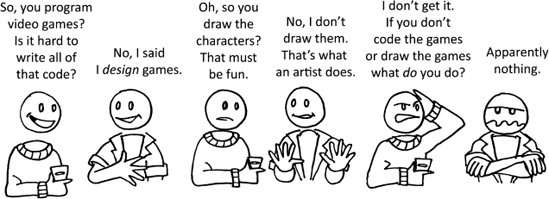
At this point in the conversation I then tell people that games are made by elves. All I have to do is leave a game design idea in the middle of the room overnight and in the morning the elves have made the game[28].
OK, this is not entirely true.
You have to leave a good idea out for the elves to make into a game. Which begs the question: "Where do good ideas come from?"
Every good idea borders on the stupid.
Michel Gondry[29]
I like this quote because many game ideas often sound stupid. Try these on for size:
A yellow creature eats dots while being chased by ghost monsters.
A plumber jumps on the heads of mushrooms to find his girlfriend.
A prince rebuilds stars by rolling balls of junk into bigger balls of junk.
All of those stupid-sounding ideas ended up being games that made lots and lots of money. I guess they aren't so stupid after all. To me, the lesson is, never dismiss a game idea, even if it does sound stupid.
So, where do I get my own stupid ideas to turn into video games? The traditional way to get an idea is to get inspired. The good news is that a good game idea can come from anywhere. Here is a list of things I do to get inspired. I suggest you try them yourself the next time you need to come up with an idea.
Read something you normally wouldn't read. I once attended a roundtable discussion with the famous game designer Will Wright. Mr. Wright said he got his inspiration for his games from Japanese gardening, architectural design, and biology. I replied that was great, as long as you were into Japanese gardening, architectural design, and biology; but what about "normal folks" who were into comic books, sci-fi movies, and video games? But to tell the truth, I realized that I knew what the answer to my question was even as I asked my question.
One of the reasons why video games sometimes feel the same is that many game developers love the same stuff. There's nothing wrong with liking video games, comics, and movies; however when developers all get their inspiration from the same things, games start to feel the same. When popular movies come out, their themes start to show up in games. When popular games come out, you find their mechanics being used in other games. Games start to feel derivative. You also get that creepy synchronicity when developers put out similar games at the same time[30]. Take the time to expand your educational horizons, even just a little. You don't have to get a degree in the subject; just thumb through a magazine or two, spend an afternoon at the library or research something new on the Internet. In other words, stop reading so much crap and break the cycle, fanboy!
Take a walk, drive or shower. When the active part of your brain is being occupied by a familiar activity like walking or driving, then your subconscious is free to start wandering and making connections it would normally never make. These connections often lead to great ideas. Besides, many game designers could stand an occasional shower. Please make sure though that if you drive to get ideas, you invest in a hands-free recording device or stop your car first before you jot down your thoughts.
Attend a lecture. I love the Game Developer's Conference because I get inspired by the game design lectures and discussions. I often end up with a notebook full of ideas. Make sure you share some of your ideas with your fellow game designers, too. It's always good to "stretch your idea's legs" to find out where it bends and where it breaks. Just be prepared to be told your ideas are stupid[31].
Play a game, preferably a bad one. Playing a good[32] video game has its benefits, but I find it more educational to play a bad game. As you play a bad game, look at the things in the game that were done poorly. Then think about what you would do to improve them. Consider how many people "invented" the airplane before the Wright Brothers built and flew their plane. Sometimes it takes several iterations on an idea before it works successfully.
Regardless of the above, follow your passion. You never know when you'll get a chance to use something you love in a game design. Even if you do read comics and play video games, if you really love something, that love will shine through in your game. Satoshi Tajiri designed Pokémon as a game version of his love for collecting insects. Dave Jaffe turned his love for Ray Harryhausen movies into God of War. Shigeru Miyamoto often turns his real-world hobbies into game designs. If you follow your passions, designing your game won't even feel like work.
It's one thing to have a good idea; it's another thing to have a marketable one. During the course of my career, I have been told many times (usually by my colleagues in the marketing department) that my idea is a "designer's idea", which means that they think my idea one that I would love to play but it isn't marketable to the general gaming public. Personally, I am torn with this assessment. On the one hand, I can understand their desire to make a game that will sell. If your game sells, that means you can make more games.
But on the other hand, before I am ready to give in to "the suits" I am reminded of all of the innovative games that have been created over the years. I am sure that at one point the designers of these games were told by their marketing colleagues that their idea was too weird, too unmarketable, or too stupid. If that were the case, then games like PaRappa the Rapper, The Sims or Braid would have never been made.
However, let me tell you a little secret. Come a little closer ... a little closer ... too close!
If you think something is innovative, it just means you haven't been paying attention. | ||
| --Scott Rogers | ||
While I am sure there is probably still a completely original idea out there in the galaxy of ideas, the majority of gameplay design works by each game building upon its predecessor. I truly believe that this strategy is one of the keys to creating great game design. Even the most innovative games like the aforementioned PaRappa, Sims, and Braid had their predecessors in Simon, Sim City[33], and Blinx: the Time Sweeper.
Here's another secret. My idea isn't even original. Raph Koster charted the evolution of the shoot 'em up genre in his book A Theory of Fun for Game Design (Paraglyph, 2004). Taking Raph's chart as inspiration, I will show you the evolution of gameplay design within the platform game genre.
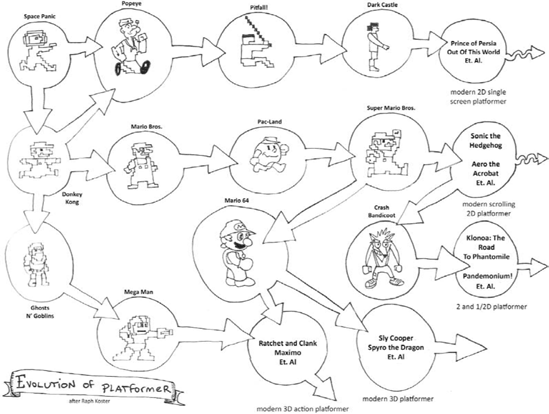
Space Panic's (Universal, 1980) walking character climbed ladders and dug holes to temporarily stun enemies.
Donkey Kong (Nintendo, 1981) added jumping and a power-up that could defeat enemies.
Popeye (Nintendo, 1982) introduced moving collectables and environmental mechanics that the player could interact with.
Pitfall! (Activision, 1982) added alternate moves including vine-swinging and hopping on alligators' heads.
Mario Bros. (Nintendo, 1983) added a second player and enemies that could be defeated by the player's skill rather than just a power-up.
Pac-Land (Namco, 1984) featured a world map, a variety of themed levels and dynamic hazards.
Ghosts 'N' Goblins (Capcom, 1985) featured multiple weapons including projectiles, health (in the form of armor that shattered off), and combatable "boss" monsters.
Super Mario Bros. (Nintendo, 1985) launched a wave of imitators who were inspired by its tight controls, whimsical environments, and creative level design.
Dark Castle's (Silicon Beach Software, 1986) hero Duncan could "hide" from enemies. It was also the first game where players didn't immediately die from falling, but rather ended up in the dungeon.
Mega Man (Capcom, 1987) introduced themed stages ending with similarly themed bosses who possessed powers that could be gained by the player once they were defeated.
Crash Bandicoot (Universal, 1996) used 3-D models and environments to create the camera view called "2.5-D."
Mario 64 (Nintendo, 1996) brought all of the gameplay of the Mario platform games into true 3-D.
As you can see, each idea builds upon the next. Each game designer inspires the one that comes after them. Or as Pablo Picasso once said, "Bad artists copy. Good artists steal."
Now that you have a great game idea to start with, you have to ask yourself:
I believe that most gamers don't know what they want until it is shown to them. That is why it is important for game designers to have ideas born from passion. To have a vision of what their game is supposed to be. Gamers can feel when developers are passionate about their games. They can smell it like a dog smells fear. Don't be afraid to hold onto your unique vision: just be aware that it may not turn out exactly how you envisioned.
But that didn't really answer the question did it? Okay, here's a simple answer:
GAMERS WANT GOOD GAMES[34]
Of course, there is no guarantee that your game will be good. While no one sets out to make bad games, bad games still get made. You can lay the blame of a bad game at the feet of a multitude of reasons, which we will be covering later on.
Tim Schaefer, the designer of Psychonauts and Brütal Legend, says that all good game characters are wish fulfillment. They give the player a chance to be something they aren't in the real world. I think the same is true about games in general. Games should make players feel something that they aren't in the real world: powerful, smart, sneaky, successful, rich, bad, or heroic.
As you are developing your idea, you need to know "What audience is my game for?" The rise of casual gaming has created an entirely new market; gamers that aren't interested in grinding away at a game for hours at a time. You need to decide who your game idea is for: the casual or the hardcore player. You can rule out certain design decisions early on by setting the audience in stone near the beginning of the idea development process.
Don't forget to ask this important question: "What is the age of my audience?" Having made dozens of "kid's" games, I have observed a useful fact about kids and games. Kids always want what is made for an audience older than their own age group. For example, an 8-year-old kid wants to play a game that is made for a 10-year-old kid. A 10-year-old kid wants to play a game that is made for a 13-year-old kid. A 13-year-old kid wants to play a game that is made for an 18 year old. Many kids aren't interested in playing games directly targeting their age range. If asked, they will tell you "that's a game for my little brother." Believe me, in kid language, there is no greater put down!
Developers, especially ones who have never made a game for kids before, tend to oversimplify and talk down to younger audiences. They say "we don't want this game to be too challenging because it is for kids." Don't make that mistake. Kids are far smarter and way better gamers than we give them credit for. Often, they pick up on concepts faster than many adults. There are some limitations you have to consider when making games for kids though. First is that their little hands can't perform overly complex control schemes. The second is with an audience in first grade or younger (6 to 7 years old), they may not be able to read many complex words or long amounts of text. And watch the swearing.
"Is it fun?" is the question I dread the most when coming up with new game ideas. Many gaming academics have attempted to define what fun is. Designer Marc LeBlanc breaks down fun into eight categories: Sensation, Fellowship, Fantasy, Discovery, Narrative, Expression, Challenge, and Submission[35] While the classification of fun is an interesting exercise, I don't find it that helpful "in the field." There are always problems. For example, a game idea (or mechanic, or boss fight, or whatever) can sound fun "on paper" but may not be fun once you get it working in the game. Or it may work, but only be fun to you.
The problem with fun is, like humor, it is completely subjective. Even if I find something fun the first time I play it, it will almost certainly not be fun on the hundredth go. This ultimately happens to all game developers while working on a game. You will play the same level hundreds of times over the course of the production. Then you start to lose all objectivity. I distinctly remember several times when a producer would come in and ask:
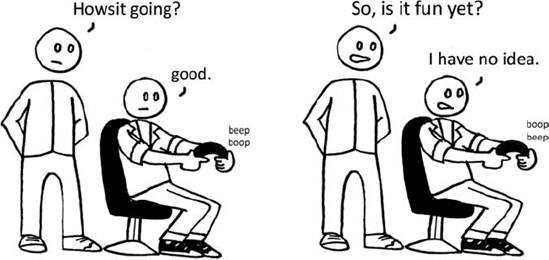
When it comes to fun and games I have found there is only one truth:
You can try to skew the odds in your favor by basing your game on existing, proven gameplay style, but more often than not, you end up with a "clone" game. Look at how many lousy first person shooters and survival horror games have been made.
Because developers always lose their objectivity during the course of production, I have created the "Theory of Un-Fun."
The Theory of Un-Fun states: start with a "fun" idea. As you develop the game, if you find something in the game that is not fun (or un-fun), then remove it. When you have removed all of the un-fun, then all that should be left is the fun.
Seems like common sense, right? And yet I have encountered many developers that have left bad gameplay mechanics and ugly art and broken cameras in their games because they got used to them or couldn't recognize them as problems. They just didn't possess the objectivity to see that something in their game was not fun. Of course, you need to start with a game idea that is fun to begin with. Otherwise, when you have removed all of the un-fun you'll be left with nothing!
The theory of un-fun must be applied several times during the game's development. Stop what you are doing and take a look at the game. Make a list to determine what is making the game "un-fun." It could be a crappy camera. Lousy controls. You could have bad animations. The game may be too hard. The game may be too easy. A producer I once worked with gave me a great piece of advice when it came to ideas. "Don't be too dear." And what he meant was don't be afraid to kill bad ideas. In other words, kill the un-fun. Don't worry, there are plenty more ideas where those came from.
When coming up with ideas, I like to brainstorm. To brainstorm properly, you need the following five things:
A working brain
Something to write with
Something to write on
A place to work
Collaborators, preferably ones who also have working brains.
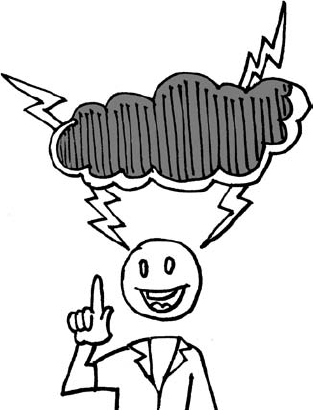
Before you start brainstorming, you need to set some ground rules. First, there is no such thing as a stupid or bad idea. Say yes to everything at this stage. Make sure you collaborate with people from other disciplines than game design: programmers, artists, testers, writers. The more diverse your brainstorming group is the better[36]. People always surprise me with what they bring to the idea creation process.
Think about all the things you want your game to be. Then write them down. Your goal is to free associate an idea as far as it can go. Milk the idea completely. When you have reached the ridiculous, then squeeze it once more and let it go. Here are some of the notes from one of my brainstorming sessions:
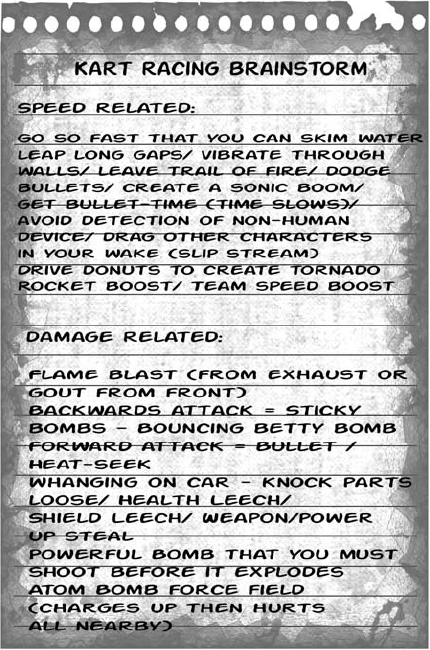
As you can see, the topics didn't really relate exactly to each other; sure, they are all things you may find a combat/driving game to have. The ideas don't have to be original at this stage either; you are merely cataloging ideas and concepts. As you design them further, then you can start thinking of things like originality or even fun.
When I am brainstorming, I like to write on a very big whiteboard. You may prefer to use lots of Post-It notes. Index cards work pretty well too. It doesn't matter. What matters is that these ideas get recorded. Even if they don't work out, you can always use them for some other game.
An excellent exercise you can use to brainstorm your game idea is to create the box and the manual. What would the cover image be? What would the bullet points on the back of the box read? How would you communicate the game in a black and white, 16-page manual? By placing these limitations on your idea, you can streamline your idea to the bare essentials. Here's an example of the back of game box that you can use as a template.
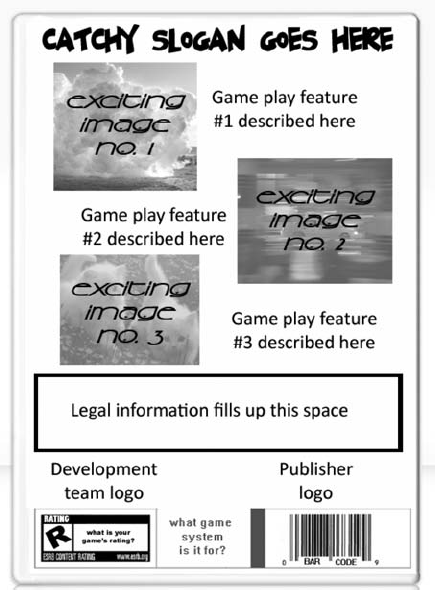
What do you do when the ideas won't come? There's no need to be ashamed. Everyone gets creatively stopped up from time to time. Here are a few tricks to try when you are dealing with writer's block.
Narrow your focus. Maybe you are trying to think of too many things at once. Tackle your problems one by one by making an outline or breaking things down to a minute level if you have to. Give yourself a time line to complete each of these tasks, but don't take days. Try to get them done in hours.
Take a walk or exercise. Everyone knows the brain is fueled by blood. Don't let that blood coagulate in your butt; get outside and move around. When your blood starts circulating again, the new ideas will be coming back in no time.
Deal with something else that may be distracting you. Sometimes when I am stuck it is because I am worrying about something else. It may be an unfiled expense report or a floor that needs vacuuming. Take a break and deal with whatever is bothering you. When it is done, it won't be a concern anymore!
Jump ahead to the good stuff. Sometimes you have to come up with ideas for game features that may not excite you as much as other parts of the game. If these are bogging you down, then go ahead and jump to the good parts. Take some time to design a boss fight rather than worrying about the UI design. However, I recommend this ONLY as a last resort as it can be very dangerous! The truth is that games are built around schedules, deadlines, and budgets. If you don't get your work done on time and choose fun over the drudge work, the game, the whole team, and even the company can suffer. Don't procrastinate. Time management is very important, so be responsible.
Change your environment. I find that my office is full of distractions. E-mail beckons, video games call out to be played, and game design documents flutter their little pages at me, begging to be read. When this happens, I get out of my office and go to the nearest conference room to work. Or sometimes I go outside to sit in the sun and get some "vitamin Duh."
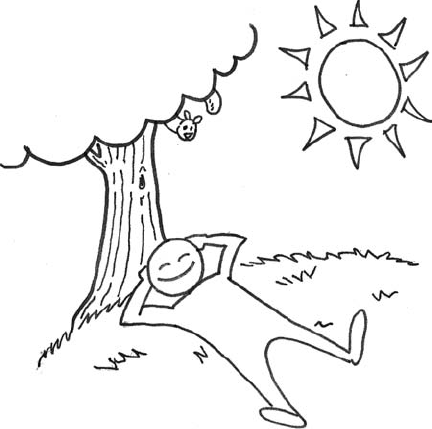
Once you have your list of ideas, it is time to get critical. Start narrowing down your list. Some items will immediately jump out as "keepers", while others are clear losers. Be merciless. It is better to have more good ideas than you can use than to have a game be full of lots of bad ideas.
Present these ideas to another party. Miyamoto has his "wife-o-meter" where he presents his ideas to his wife. If she hates them, they get thrown away. I used to have the executive assistants in my office take a look at game ideas. Someone who has no vested creative interest in your ideas will often give you the clearest and most honest insight.
Now that you have your ideas, let's put them to good use!
Level 2's Universal Truths and Clever Ideas:
All gamers want are good games.
You have no guarantee that your game is going to be fun.
Start with a "fun" idea. As you develop the game, remove the "un-fun." All that should be left is the fun.
Don't be so dear with your ideas. Throw out some good ideas along with the bad if they don't fit or have more than you need.
Ideas are cheap, it's how you use them that matters.
If you're stuck, take a break—but don't procrastinate.
[28] They also make shoes, Christmas toys and cookies the same way.
[29] While Michel Gondry doesn' t make video games, he does make excellent movies like Eternal Sunshine of the Spotless Mind, The Science of Sleep, and Be Kind, Rewind. I suggest you add them all to your Netflix lists immediately.
[30] This is the same phenomenon that gave us two volcano-themed movies in one year, Dante's Peak and Volcano, back in 1997.
[31] And then when someone tells you your idea is stupid, you can retort with Michel Gondry's quote!
[32] I realize that "good" is extremely subjective. Good could mean highly rated, best-selling, competently made or even just damn cool.
[33] Will Wright, the creator/designer of The Sims, is one of, if not the smartest guy in video games. His genius is that his entire video game career appears to be dedicated to the iteration of a single idea. His creations, Sim City, Sim Ant, Sim Earth, Sim City 2000, The Sims, and Spore, showcase the natural evolution of a single idea (the world building simulation) to literally galactic proportions. That he has been able to develop and polish this idea over the years is a luxury of which any game designer would be envious.
[34] Yes, this is in ALL CAPS and bold because it is a VERY IMPORTANT THING.
[35] Taken from Mark's GDC lecture and corresponding website: http://www.8kindsoffun.com/.
[36] Keep in mind that everyone you invite to your brainstorming session should understand how to make a game though, otherwise you might waste a lot of time on unrealistic ideas.
